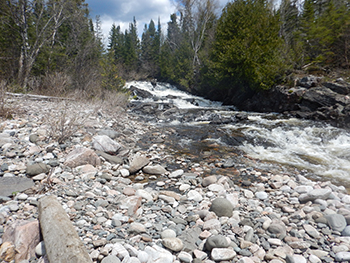
Pukaskwa fish tails
Pukaskwa National Park
by Chris Robinson
Lakewide Action and Management Plans (LAMPs) are binational action plans for restoring and protecting the Great Lakes ecosystem. Pukaskwa National Park sits along the longest stretch of undeveloped coastline on the Great Lakes and contains an array of ecosystems in its’ endless coves, bays and coastal streams. In the summer of 2016, several LAMP projects were undertaken along the Pukaskwa National Park coastline.

As a member of the Lake Superior Partnership Management Committee, Pukaskwa National Park supports initiatives of the Lake Superior LAMP and projects within it led by partners such as the Ontario Ministry of Natural Resources and Forestry (OMNRF) and the Department of Fisheries and Oceans Canada (DFO).
In the summer of 2016, Pukaskwa National Park staff assisted DFO and OMNRF with an index netting project for juvenile lake sturgeon (Acipenser fulvescens). Lake sturgeon were measured, tagged, and released in the nearshore waters of the park where they have been historically known to spawn. These impressive freshwater fish are the largest in Ontario, and can live well over 100 years. Provincially Threatened, their populations have dwindled over the years due to loss of spawning habitat and overfishing. In total, 24 lake sturgeon were captured and released along Pukaskwa’s coast, 20 of which were juvenile.
Another two LAMP projects that Pukaskwa National Park assisted with were brook trout (Salvelinus fontinalis) and lake trout (Salvelinus namaycush) monitoring in coastal streams, led by the OMNRF. These species both require cold and well-oxygenated waters to survive. Brook trout were found in Imogene Creek, in the south end of the Park, where annual water temperatures typically stay below 16°C, the preferred maximum temperature for brook trout. Groundwater fed tributaries and shading of water by vegetation are believed to contribute to keeping the water cool in this stream. Although Brook Trout was found in only one coastal creek, there are many upstream and inland tributaries where water temperatures are cooler and brook trout persist.

Unfortunately there was no luck in re-locating river-spawning lake trout in four of the Park’s coastal streams. Lake trout are typically lake-spawning fish. They lay their eggs on rocky shoals in lentic (non-flowing) waters, such as Lake Superior and deep in-land lakes. But as is the case in biology, there are always exceptions, and such is the case with some lake trout. A few scattered populations, mostly in the arctic but some also in Lake Superior, choose to spawn in rivers. Work is ongoing by the OMNRF in the Dog (University) River and Montreal River, just southeast of Pukaskwa National Park, where two of the largest known populations of these river-spawning fish persist in Lake Superior.
Lake trout populations in Lake Superior collapsed in the 1950s after sea lamprey (Petromyzon marinus) invaded the Great Lakes. Thanks to control efforts of the Great Lakes Fishery Commission (GLFC) since 1956, populations are recovering but continue to threaten the native fish community today. Before maturing, lamprey live as small, non-parasitic worm-like creatures called ammocoetes in the sand and silt of streams and rivers. This is when they’re most susceptible to a chemical, called 3-trifluoromethyl-4-nitrophenol (TFM), or more simply lampricide. In 2016, the GLFC applied lampricide in the White River in Pukaskwa National Park. No other species were observed to be affected by the treatment.
Lastly, in collaboration with the Ontario Ministry of Environment and Climate Change, another fish netting project was undertaken in the White River to assess the level of contaminants on sport fish. When the analysis is complete, the information will be available through the Guide to Eating Ontario Fish for the White River below Chigamiwinigum Falls, a popular fishing destination in the Park.
Pukaskwa National Park boasts a coastline of diverse fish and fish habitat with a great deal yet to be discovered about the species that call it home. The work conducted last summer contributes to the binational goals of the Lake Superior LAMP and ultimately will help enhance our knowledge of restoring and maintaining healthy fish communities in Lake Superior.
<< Back to shoreLINES- Date modified :